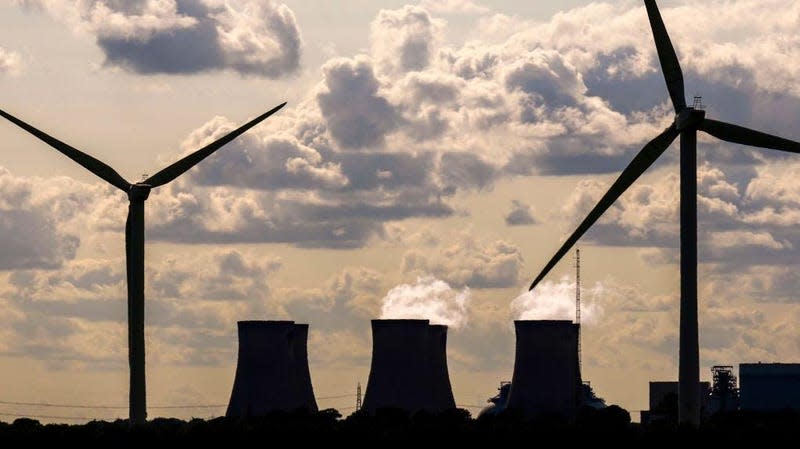Carbon Capture Tech Hype Is Fizzling Out, IEA Says
Angely Mercado
Tue, September 26, 2023

Wind turbines generate electricity as the Drax Power Station in the background also generates electricity on June 29, 2023 in Selby, England.
The International Energy Agency (IEA) has released an updated road map this week for reaching zero greenhouse gas emissions by 2050. The new report emphasizes that solutions like carbon capture technology and carbon credits have not lived up to their promise of removing CO2 from our atmosphere, while renewables have made the most progress toward reaching lower emissions targets.
The IEA initially released its first landmark roadmap report back in May 2021 where it outlined that the world needed to end fossil fuel development ASAP. The new IEA report explains that international cooperation and investment in clean energy have shown the most promise for averting the worst of the climate crisis. Emerging tech like hydrogen fuel cells and other emissions-capturing claims previously accounted for an estimated 50% reduction of emissions to reach net zero by 2050 in the 2021 report. Those methods only make up 35% of emissions reduction in this new version of the IEA’s roadmap.
The use of carbon credits and carbon capture were not completely denounced in this week’s roadmap, but the IEA report emphasized that they are tools to use alongside other emissions-lowering solutions. “The credibility of carbon credits has suffered in recent years as a result of market design imperfections and some cases of abuse,” the roadmap explained. “It is essential to ensure that carbon credits are generated from real, verified, additional and permanent emissions reductions or removals.”
The report suggested applying industry guidelines including Article 6 of the Paris Agreement, which describes the creation of a global carbon market for transparency and accuracy. It also suggested that corporations receive more guidance on how to formulate their CO2 removal strategies. This is because some companies that have claimed to use carbon offset technologies have used pretty questionable tech in the recent past. Late last year, Drax Group, a UK clean energy company, was selling offset credits based off of U.S.-based power plants that the company hadn’t even built yet.
Hydrogen also played a smaller role in this year’s report as a climate solution. The updated roadmap describes current hydrogen-based technology as another source of unneeded emissions. “Demand for hydrogen is rising, reaching 95 Mt in 2022, but most of it is met by emissions-intensive supply, resulting in more than 0.9 Gt of direct CO2 emissions in 2022,” the report explained.
Relying on hydrogen and carbon capture tech hasn’t really solved much, which means the world should put efforts and financing toward expanding renewables. Clean energy capacity will need to triple worldwide by the end of this decade to avoid further warming, the roadmap says.
This report comes after the northern hemisphere experienced its hottest summer on record, signaling what the future could hold for billions worldwide if we don’t lower emissions by the middle of this century.
Want more climate and environment stories? Check out Earther’s guides to decarbonizing your home, divesting from fossil fuels, packing a disaster go bag, and overcoming climate dread. And don’t miss our coverage of the latest IPCC climate report, the future of carbon dioxide removal, and the un-greenwashed facts on bioplastics and plastic recycling.
Gizmodo
No comments:
Post a Comment